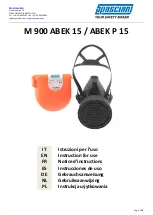
Heated Diode
Refrigerant
Leak Detector
Model: SRL8
OPERATOR’S MANUAL
Description
The SRL8 uses a tin dioxide semiconducting gas
detector (heated diode) and microprocessor to cre-
ate a highly sensitive portable refrigerant leak
detector technology with superior battery life, porta-
bility, and ease of use.
Gas is pumped through the tip of the wand into
the sensor at the base of the snoot. The sensor
chemically reacts with any refrigerant in the incom-
ing gas, sending a mV signal into a microprocessor
controlled circuit.
The SRL8 can detect leaks smaller than 0.1
oz/year, which exceeds the toughest SAE J1627
standards. The SRL8 comes with wall and car
charger for its ultra-compact Li-ion battery which
powers the SRL8 for 15 hours of continuous opera-
tion before a recharge is needed. That's long
enough to last your
entire workday.
The SRL8 has
variable sensitivity
settings, to give you
the sensitivity you
need while eliminat-
ing 'nuisance tripping'. A quick, automatic 30 sec-
ond self-calibration upon power-up ensures optimal
performance.
A built in replaceable filter blocks moisture and
harmful particulates. The SRL8 also has manual
and automatic "Zeroing" function to ensure the best
sensitivity possible by canceling out background
contamination. Use the MUTE button to silence the
detector's audio indicators when needed.
Operation
ON/OFF Protection
To turn on/off the SRL8 press and hold the
ON/OFF button for one second. This slight delay
protects against inadvertent powering on or off,
conserving battery life. If you forget to turn the
SRL8 off, it will automatically turn off after 10 min-
utes of inactivity.
LED Bar Graph Display
The eight segment LED display indicates the
concentration of refrigerant detected. As the con-
centration of refrigerant in the air increases so does
the number of lit bars on the display.
L/M/H Button (Sensitivity)
Set the sensitivity level by pressing the L/M/H
button. Low (L), medium (M), or high (H) sensitivity
will be indicated by the respective LEDs.
The higher the concentration of refrigerant in the
ambient air, the lower the sensitivity setting should
be to minimize false trips.
MUTE Button and Battery check
Pressing the MUTE button toggles the sound of
the SRL8 on and off. In addition, holding the MUTE
button down for one second will display the remain-
ing percent of battery charge on the LED bar graph.
ZERO Button and Auto-Zeroing function
The SRL8 has two zeroing modes, manual and
automatic, which are indicated by the "Auto-Zero"
LED being off or on respectively. These modes
allow the user to achieve the best sensitivity possi-
ble by setting the baseline signal equal to any back-
ground contamination.
The SRL8 defaults to the automatic zeroing
mode when turned on. In automatic mode, the
SRL8 will zero itself to the ambient environment
every two seconds if not triggered. Zeroing is indi-
cated by a quick double flash of the "Auto-Zero"
LED.
To switch between the auto and manual zeroing
modes hold the ZERO button down for one second.
The "Auto-Zero" LED will no longer be lit when in
manual mode. To manually zero the SRL8 in this
mode, simply press the ZERO button in a non-con-
taminated environment. The SRL8 will indicate suc-
cessful zeroing by a quick double flash of the "Auto-
Zero" LED.
Leak Detection Procedure
Keep the SRL8 away from any areas of potential
refrigerant leakage until the warm-up and calibration
period is over. The warm-up and calibration
sequence lasts about 30 seconds after ON/OFF is
pressed. Allow the SRL8 to fully warm-up before
using. On startup, meter defaults to high sensitivity
and auto-zeroing.
The most likely points for refrigerant leaks are at
the soldered joints in refrigerant lines and changes
in cross section or direction of these lines.
The SRL8 detects concentration of refrigerant.
The zeroing function lets the user easily detect leaks
in places that may have refrigerant in the air, such
as a refrigerator leaking into an enclosed space.
When detecting:
1. The tip of the snoot should be fairly close to the
line. You may need to be within 1/4” (0.64cm) of
a small leak to detect it. In this case, using a
second hand to guide the tip along refrigerant
lines may be helpful.
2. Keep the tip moving along refrigerant lines at a
rate of 1-3 inches per second.
3. As the SRL8 detects a leak its alarm will sound
and the LED bar graph will light up. As you move
the snoot closer to the point of the leak, more
LEDs light up as the concentration increases.
(Note: If the SRL8 wand moves through a very
high concentration of refrigerant, you may need
to wait for the SRL8 to re-zero or manually zero
it in order to let the sensor readjust, before mov-
ing to step 4.)
4. Once the maximum refrigerant concentration is
located, allow the meter to zero away from the
leak. Then do a second sweep of the suspected
leak point, to verify its location.
Filter Assessment & Replacement
The filter blocks moisture and other contaminants
from the sensor. When it gets wet, it constricts flow
of air, and the filter should be replaced. Unscrew the
sensor tip and replace the white filter so that the
rounded end is at the tip of the wand. Use only the
Fieldpiece supplied filter.
Extra filters can be ordered from a distributor.
Model RFL2 contains 10 filters and 5 O-rings.
Installing and Replacing Sensor
Replacement sensors (model RHD1) can be
ordered for the SRL8. To install or replace the sen-
sor, make sure the unit is turned off. Then,
unscrew the snoot on the SRL8 and if replacing
gently pull the sensor from the base.
Carefully insert the new sensor and replace
snoot. The sensor can be inserted in two different
configurations, either of which will allow the SRL8
to function correctly.
If no sensor is installed or the installed sensor is
broken when the unit is turned on an alarm will
sound and the unit will turn off.
Quick Tips
1.
To pinpoint larger leaks, adjust sensitivity.
2.
Make sure the SRL8 is zeroing between detec-
tions. Look for the double flash of the auto-zero
LED.
Comparing Leak Detectors
Fieldpiece has two leak detectors. The SRL8
uses a heated diode sensor. The heated diode's
advantage is that it detects absolute concentration
levels so it can be held on a leak and will continue
to beep. It is also initially very sensitive. Its major
disadvantages are that the sensor becomes less
sensitive over life, eventually needing replacement
and it is more sensitive to some refrigerants than
others.
The SRL2 uses an infrared (IR) sensor. It
detects a CHANGE in concentration, so the wand
must keep moving. The main advantages of the
Fieldpiece IR sensor are that its sensitivity will
remain the same over the life of the instrument,
the sensor will last the lifetime of the instru
ment, it will not trigger on humidity or on oil,
and it has nearly the same sensitivity to most
refrigerants.The main disadvantage of infrared
sensors is their sensitivity to mechanical
disturbances.
SRL8 testing an A-coil, 1/4” (0.64cm) from the line.
1/4”
(0.635cm)
SENSITIVITY
H
M
L
AUTO-ZERO
LOW-BATT
SRL8
ON/OFF
MUTE
ZERO
L/M/H
Heated Diode
Refrigerant
Leak Detector
PRESS FOR
1 SECOND
BATTERY
CHECK
SENSITIVITY
H
M
L
AUTO-ZERO
LOW-BATT
Caution
DO NOT use the SRL8 without the proper fil-
ter correctly installed. Doing so may result in
damage to the instrument.
!
Warning
The sensor may be hot after use.
!
!
!
99 Washington Street
Melrose, MA 02176
Phone
781-665-
1400
Toll Free 1-800-517-8431




















